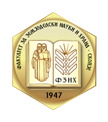ESTIMATION OF FURAN LEVELS IN SOME CANNED FOODS IN EGYPT AND HOW TO REDUCE IT
Клучни зборови:
Furan, canned foods, thermal treated, EgyptАпстракт
Furan is naturally occurring compound found at low levels in many foods. Furan has been formed in a wide range of thermally treated foods especially heated foods sealed in cans and jars. The primary source of furan in food is thermal degradation and rearrangement of organic compounds. Furan is a five-membered ring which can induce tumors and liver toxicity in experimental animals and is classified as ‘possibly carcinogenic to humans’ by the International Agency for Research on Cancer. In this study furan levels in several kinds of canned and jarred foods from Egyptian markets have been estimated. Also, several heat treatments have been applied for some food samples aiming to reduce furan content in these samples. Noticed levels of furan have been shown in tested samples. Coffee samples had higher content of furan in comparison to other products. After thermal treatments the obtained results show that, furan content reduced to about 38-50% of the original content for 50o C at 5 min and the loss percent raised to about 55-71% at 20 min. At 60o C, furan content reduced to about 47-56% of the original content at 5 min and the loss percent raised to about 62-78% at 20 min. And at 70o C, furan content reduced to about 53-59% at 5 min and the loss percent raised to about 70-89% at 20 min.
Референци
CCFAC the Codex Committee on Food Additives and Contaminants (1989): Guidelines for simple evaluation of food additive intake. CAC/GL 03. Codex Alimentarius international food standards.
European Commission Decision (2002): EC concerning the performance of analytical methods and the interpretation of results. Official Journal of European Communities, L 221:8-36.
FDA/ CFSAN, FDA/Center for Food Safety & Applied Nutrition (2004): Determination of Furan in Foods. CFSAN/Office of Plant and Dairy Foods. May 7.
Goldmann, T., Perisset, A., Scanlan, F. and Stadler, R.H. (2005): Rapid determination of furan in heated foodstuffs by isotope dilution solid phase microextraction-gas chromatography-mass spectrometry (SPMEGC-MS). Analyst, 130,878-883.
International Agency for Research on Cancer (IARC) (1995): IARC Monographs on the Evaluation of Carcinogenic Risks to Humans, Volume 63, pp. 394-407.
JECFA ( 2010): Joint FAO/WHO Expert Committee on Food Additives Report of the seventy-second meeting (final edited), Rome, 16–25 February 2010.
Kim TK, Lee YK, Park YS and Lee KG (2009): Effect of cooking or handling conditions on the furan levels of processed foods. Food Additives & Contaminants: Part A 26:767-775.
Limacher A, Kerler J, Conde-Petit B and Blank I (2007): Formation of furan and methylfuran from ascorbic acid in model systems and food. Food Additives & Contaminants 24, S1: 122-135.
Maga JA. (1979): Furans in foods. CRC Critical Reviews in Food Science and Nutrition, 355-400.
Mark J, Pollien P , Lindinger C , Blank I and Märk T (2006): Quantitation of furan and methylfuran formed in different precursor systems by proton transfer reaction mass spectrometry. J Agric Food Chem 54: 2786-2793.
Morehouse K, Nyman P, McNeal T, Dinovi MJ and Perfetti G, (2008): Survey of furan in heat processed foods by headspace gas chromatography-mass spectrometry and estimated adult exposure. Food Additives and Contaminants, 25(3), 259-264.
Perez L C and Yaylayan V A (2004): Origin and mechanistic pathways of formation of the parent furan—a food toxicant. J Agric Food Chem 52: 6830-6836.
US FDA (2004): United States Food and Drug Administration Furan in Food, Thermal Treatment; Request for Data and Information. Federal Register 69: 25911–25913.



